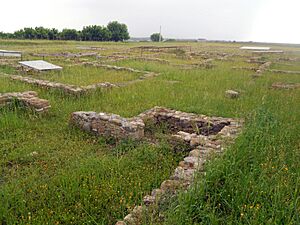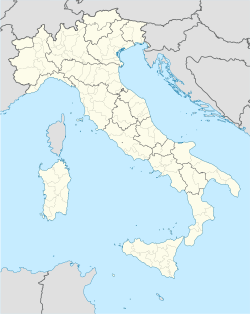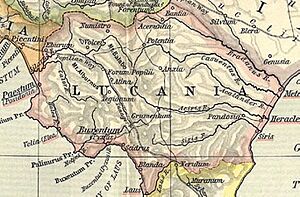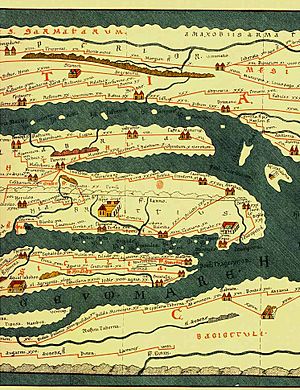Heraclea Lucania facts for kids
|
Ἡράκλεια
|
|

Foundations of building walls at Heraclea
|
|
| Location | Policoro, Province of Matera, Basilicata, Italy |
|---|---|
| Region | Magna Graecia |
| Coordinates | 40°13′12″N 16°40′11″E / 40.22000°N 16.66972°E |
| Type | Settlement |
| History | |
| Builder | Colonists from Tarentum and Siris |
| Founded | 432 BCE |
| Events | Battle of Heraclea |
| Site notes | |
| Condition | Ruined |
| Ownership | Public |
| Management | Soprintendenza per i Beni Archeologici della Basilicata |
| Public access | Yes |
| Website | Area archeologica di Herakleia |
Heraclea, also known as Heracleia or Herakleia (Ancient Greek: Ἡράκλεια), was an important ancient city. It was located in southern Italy, right on the Gulf of Taranto. The city was built between two rivers, the Aciris (now called Agri) and the Siris (now called Sinni).
Today, you can find the remains of this old city near the modern town of Policoro. This area is in the Province of Matera, within the Basilicata region of Italy.
Contents
History of Heraclea
Heraclea was a Greek colony, but it was founded later than many other Greek cities in Italy. The land where Heraclea was built first belonged to another Greek city called Siris. After Siris fell, nearby cities fought over its land.
Founding the City
The people from Athens had a claim to the land of Siris. So, their colonists from Thurii also claimed it. However, the people of Taranto (Tarentines) disagreed. This led to a war between Thurii and Taranto.
They eventually made a deal to end the fighting. They decided to build a new colony together in the disputed area. Even though both cities helped, the new settlement was officially called a colony of Taranto.
The few remaining people from Siris joined the new colonists. It seems the new city was first built on the old site of Siris. Later, it was moved about 24 stadia (around 4.5 km) closer to the Aciris river. This new city was named Heraclea. Siris still existed but became a smaller port for Heraclea.
The city of Heraclea was founded in 432 BCE. This was 14 years after Thurii was settled. Ancient writers like Diodorus and Livy called it a colony of Taranto.
Growth and Importance
Heraclea quickly grew strong and wealthy. This was thanks to the support of the Tarentines. They even fought a war against the Messapians to protect Heraclea.
Heraclea became a very important meeting place for the Italiot Greeks. This was a general assembly (πανήγυρις) that started as a religious gathering. But it also became a place for political discussions. Alexander of Epirus, a king from Epirus, tried to move this meeting to Thurii. He wanted to weaken Taranto's power.
Heraclea was known for its rich and fertile land. This helped the city become very prosperous. We don't know much about its early history, though. It likely joined Taranto in wars against the Messapians and Lucanians. Heraclea slowly became somewhat dependent on Taranto, but it remained an independent state.
Wars and Roman Alliance
When Alexander of Epirus turned against the Tarentines, he captured Heraclea. He then moved the Greek assemblies to Thurii.
During the war between Pyrrhus and the Romans, Heraclea was the site of a major battle. In 280 BCE, the Roman consul Laevinus was completely defeated by King Pyrrhus. This famous battle, known as the Battle of Heraclea, took place between Heraclea and the Siris river.
Heraclea was allied with Taranto and the Lucanians against Rome at this time. To break this alliance, the Romans offered Heraclea a very good peace treaty in 278 BCE. This treaty was so special that Cicero called it "almost unique."
Heraclea kept these special rights throughout the Roman Republic period. Even when the Lex Plautia Papiria law in 89 BCE offered Roman citizenship to all Italian cities, Heraclea's people thought carefully before accepting.
Heraclea was forced to surrender to Hannibal in 212 BCE. We don't know much about Heraclea during the Social War. However, Cicero mentioned that all the city's public records were destroyed by fire during that time. This suggests the city suffered greatly.
Despite this, Cicero still described Heraclea as a thriving and important town. It was one of the few Greek cities in southern Italy that remained significant under Roman rule. Although the geographer Ptolemy didn't mention it, later maps and travel guides confirm its existence. Heraclea was still an important place during the Roman Empire.
Decline and Ruins
We don't know exactly when or how Heraclea disappeared. Today, the area is deserted. The land, once very fertile, was mostly empty by the mid-19th century.
However, the location of the ancient city is clear. While there are no grand ruins left, large piles of rubble and foundations of old buildings mark the site. These are near Policoro, about 5 km from the sea. Many ancient coins, bronze items, and other artifacts have been found there. A medieval town called Anglona was later built on the site. It was once a bishopric (a church district), but now it is also just ruins.
Tables of Heraclea
The famous bronze tablets, known as the Tables of Heraclea (Tabulae Heracleenses), were found near Heraclea. They were discovered between Heraclea and another ancient city called Metapontum. These tablets are very important for studying Roman Law.
Art and Coins
Heraclea is often thought to be the birthplace of the famous painter Zeuxis. However, it's not certain which city named Heraclea he was from.
The beautiful and varied coins found from Heraclea show that art was important there. These coins are considered some of the finest examples of Greek art. Their large number also proves that Heraclea was a wealthy city with a lot of trade.
Gallery
-
Silver coin from Heraclea (390-340 BC). Obv. Head of Athena with inscription ΗΡΑΚΛΗΙΩΝ, i.e. "of Heracleans". Rev. Herakles wrestling with the Nemean lion.
See also









